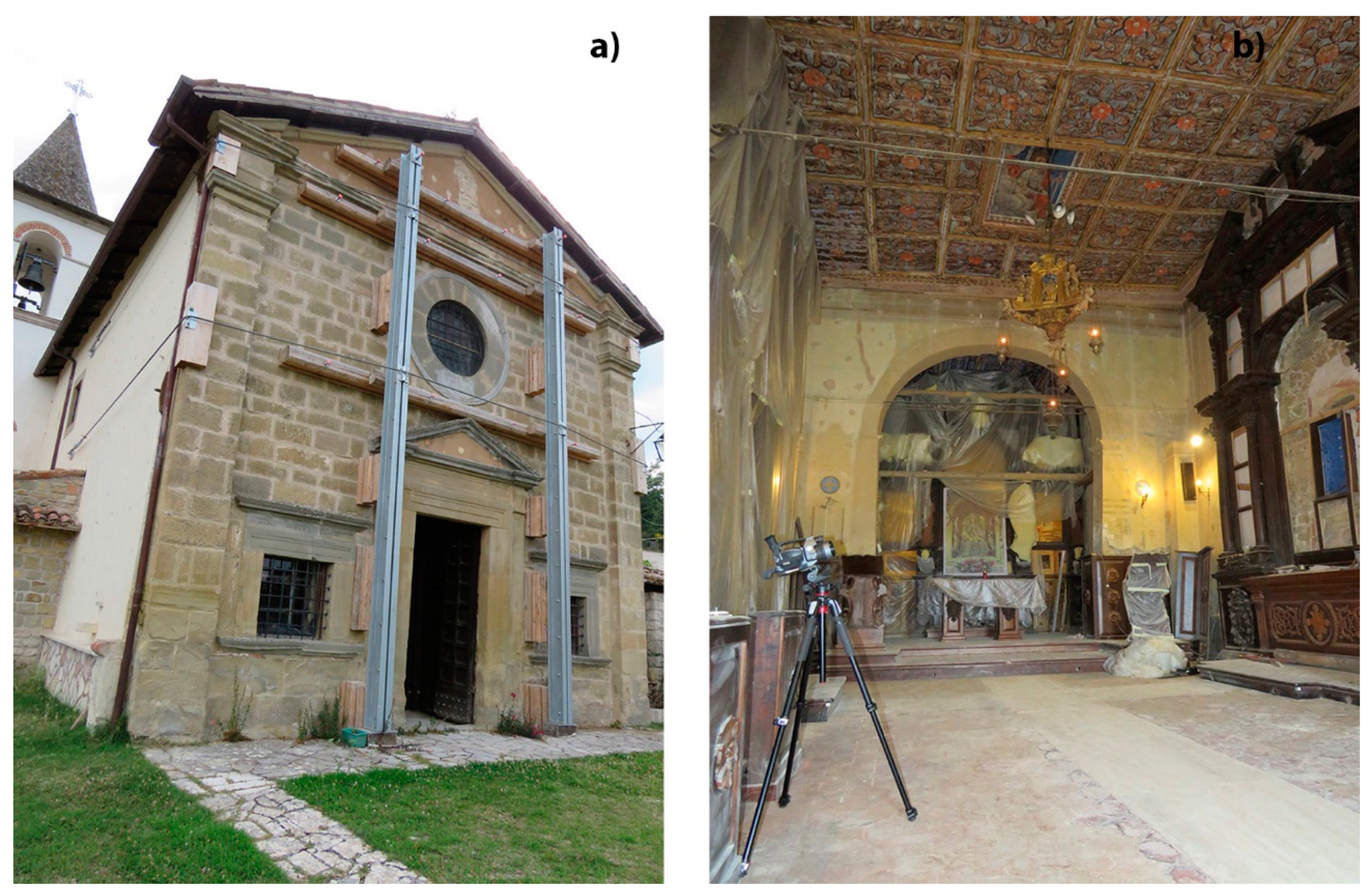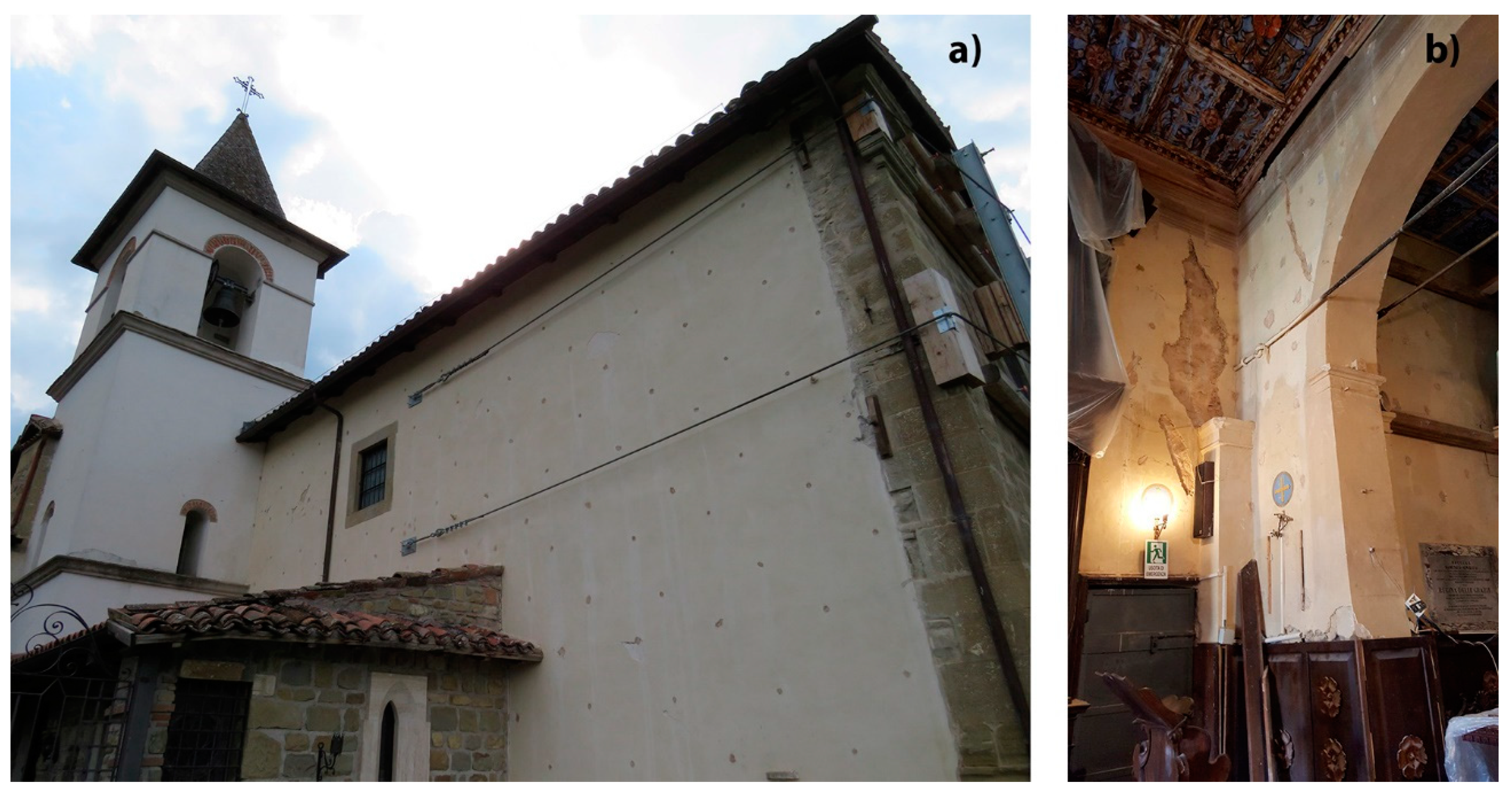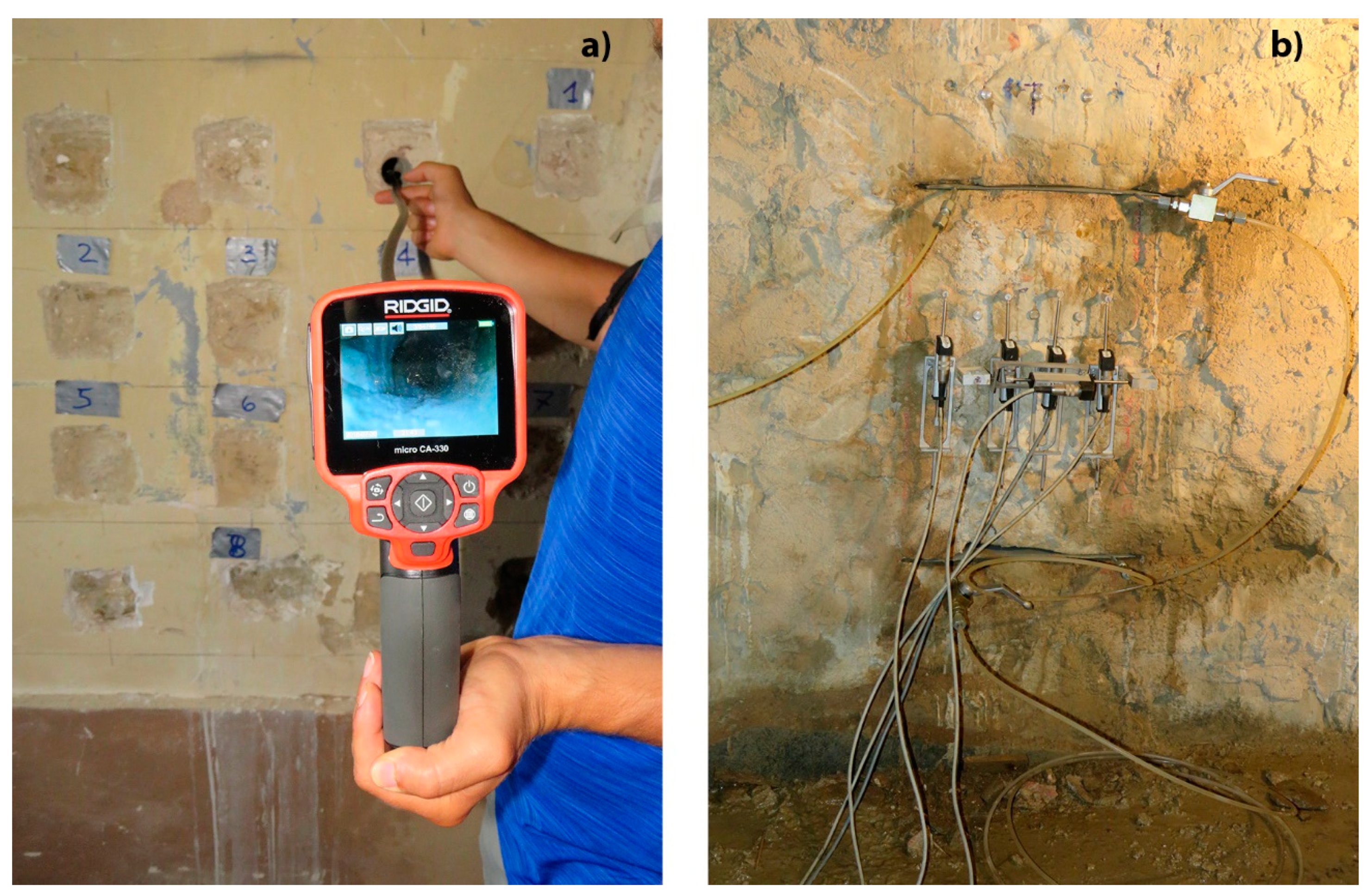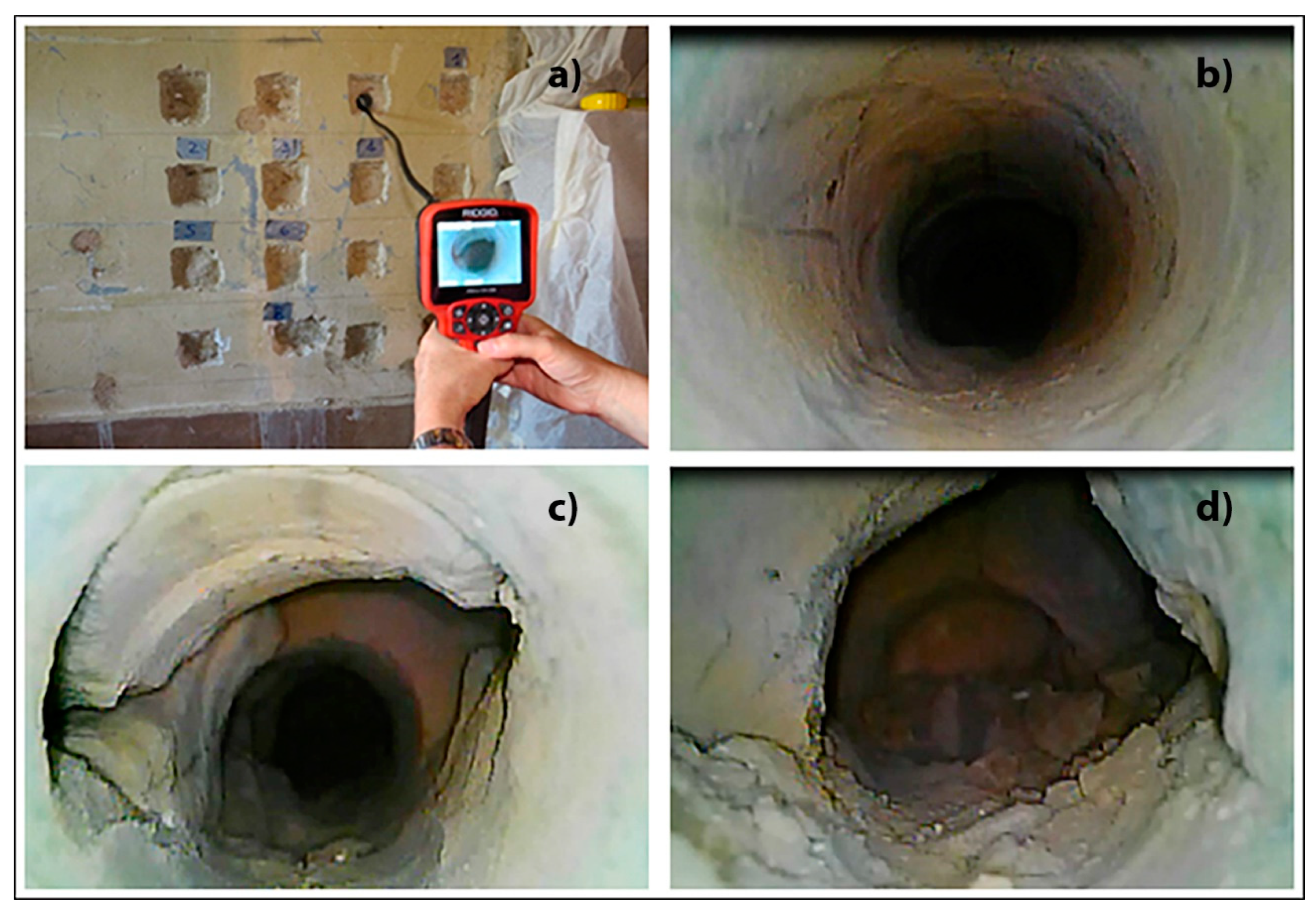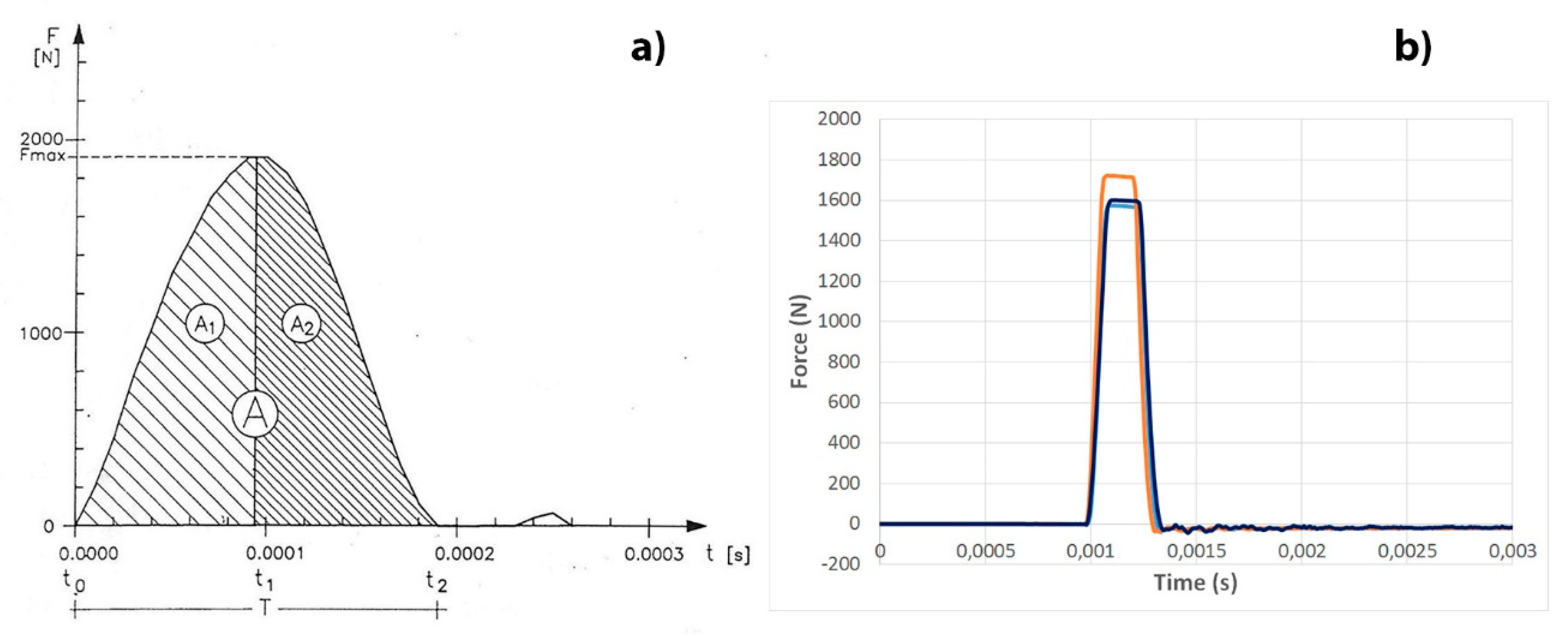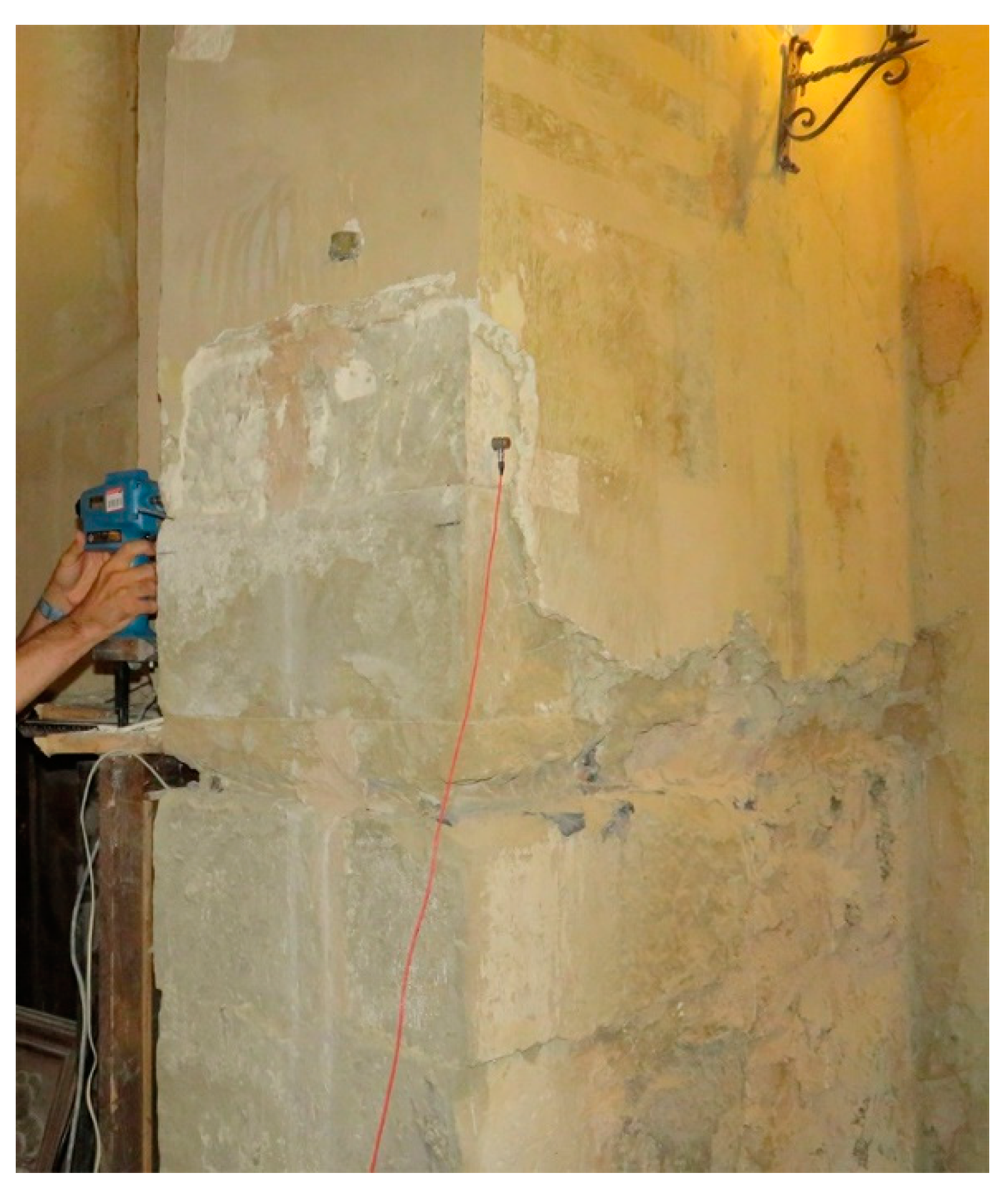1. Introduction
The immense historical and architectural heritage is increasingly in need of safety measures and seismic improvement in order to preserve monumental buildings, especially against violent earthquakes. The problem of safeguarding historical buildings is particularly felt in Italy, where, after recent earthquakes, many churches and monumental buildings have collapsed ruinously, losing precious evidence of historical art and architecture [
1,
2,
3,
4]. The structural vulnerabilities of the historical monuments reside in the poor connections between walls and floors, often simply combined as a sum of different buildings over time, and in the quality and strength of the masonry structures. The historical wall textures are very diversified due to construction techniques and the level of degradation suffered over time. Some of them are particular and deserve a more in-depth study of structural behavior, especially with regard to dynamic actions [
5].
This study describes the results of sonic and impact tests performed on the masonry walls of the Sanctuary of Santa Maria delle Grazie in Varoni, near Amatrice, damaged by the 2016 Central Italy earthquake. The purpose of the tests was the characterization of the mechanical properties of the wall texture to better understand the seismic vulnerabilities of the church. Some more destructive tests were also needed, such as endoscopy and flat jacks. It was very important to correlate the results of the different tests, confirming the potential to extract, from the non-destructive tests, a lot of information then confirmed by the more destructive ones. Therefore, the sonic and impact tests allowed us to limit the execution of more destructive tests. This possibility is very important in the field of cultural heritage to preserve artistic integrity as much as possible [
6].
The Sanctuary of Santa Maria delle Grazie is a church from the 15th century built by unordered masonry stone. The church suffered limited damage after the big seismic shock of 24 August 2016, concentrated, above all, in a slight principle of out of plane mechanism of the façade and some failures in the masonry structures (
Figure 1). During the long seismic swarm of the 2016 Amatrice earthquake, the Government Department responsible for monuments carried out some punctual safety works. They consisted in a preliminary execution of lime mortar injections inside the stone walls in order to offer greater strength to the contrast of the new tie rods inserted in the façade plane, in the arch triumphal interior and contrast to the shoring of the facade (
Figure 2).
The mortar injections were carried out for a limited depth inside the masonry wall, since there were uncertainties about the possible presence of a multi-layer stone masonry empty between the wall layers.
The Politecnico di Torino, through its MastrLab Laboratory, was commissioned to carry out an in-depth diagnostic campaign for the mechanical characterization of masonry structures useful for the subsequent planning phase of seismic improvement of the church. In particular, the main purpose was to evaluate whether the mortar injections, carried out for safety purposes, had an effect on the increase in the strength of the stone walls, and to show whether the walls themselves were a multi-layer texture.
2. Materials and Methods
The evaluation of the quality of the wall texture and the effectiveness of the mortar injections was performed by comparing the results of the semi destructive tests, such as the double flat jacks [
7,
8,
9,
10,
11] and the endoscopy, with those of the non-destructive sonic type tests.
The sonic tests were performed on a masonry sample of the church, measuring the speed of crossing the sonic wave on a mesh of points within the sample surface [
12]. The sonic test was carried out using an electric instrumented hammer, which allows to apply an impulsive force, by a small spherical surface mass, on the surface of the analysed masonry and generate a sonic wave. The instrumented hammer was equipped with a load cell and connected to an acquisition system that allowed recording the time-amplitude function of the force exerted on impact. Mechanical energy was transformed into acoustic-vibrational energy and the wave propagates in the analysed material volume. A receiving sensor (monoaxial accelerometer) was responsible for recording and transmitting to the acquisition system the response of the material to the propagation of the signal in the section; the response was recorded as a waveform that represented the variations in amplitude of the vibrations occurred at the surface in a short span of time. The propagation of the wave in the analysed material was influenced by the geometry of the section as well as by the physical-mechanical characteristics of the material crossed.
The electric impact hammer used was PCB Piezotronics; model 086B09; variable force from 44.48 N to 4448.26 N; force sensor PCB model 208M51; 2.47 mV/N load sensor sensitivity. An accelerometer was used to receive the impulsive signal (
Figure 3). The Dytran monoaxial accelerometer used in conjunction with an amplifier had the following technical characteristics: Dytran model 4102 C; model 3055B4; sensitivity 51.6 mV/g; measuring range: ±100 g; frequency response: 1 ÷ 10,000 Hz; mass: 10 g. Finally, a signal analyzer recorded both the applied load pulse and the sonic wave signal.
The electric instrumented hammer allowed to know the evolution over time of the forces between the impact mass and the tested material and to know many parameters that other impulsive methods would not allow. The concrete sclerometer test was limited only to the detection the elastic energy returned by the material after the impact, proportional to the rebound length of the mass. Instead, the impact hammer test also allowed us to know the given energy, the dissipated energy, the duration of the impact and the maximum load that can be evaluated [
13]. The impact method allowed us to assess the elastic and inelastic properties of the materials, in particular, the elastic modulus of the big stones inside the masonry texture [
14].
Endoscopy was performed with a RIDGID micro-CA 330 endoscope model (
Figure 4a). The semi-destructive test to assess the main mechanical characteristics of the masonry was carried out using 4 mm thick and 77,765 mm
2 area flat jacks [
9] (
Figure 4b) through a hydraulic pump equipped by a DMM2 digital pressure gauge (linearity and 0.05% hysteresis) with a flow rate of 100 bar. The measurement of length variations was performed continuously by potentiometric displacement transducers (manufacturer: Novotechnik; model: TR50; stroke: 50 mm; deviation from linearity: 0.2%). The pressure and displacement values were acquired continuously using the HBM Spider8 acquisition device with a sampling frequency of 5 Hz. A hydraulic saw with a diamond disc was used to make the cut in which the jacks are to be positioned. Usually the pressure of the liquid in the jack was greater than the effort that the jack exerted on the masonry. In fact, the flat jack, because of its stiffness, was opposed to expansion when it was inflated, so the jack must be calibrated to obtain a a conversion factor (km) that correlated the internal pressure of the fluid with the force applied to the masonry. The jack was calibrated in the laboratory through a compression test machine with a capacity of at least 450 kN. Through the loading-unloading cycles, entering the liquid under pressure inside the jack bound to the test machine plates, it was possible to obtain the conversion factor (km) as the angular coefficient of the straight line in the pressure-load diagram. The calibration, performed at the laboratory of the Politecnico di Torino according to the technical code ASTM C1197-04 [
8], provided a value of km equal to 0.842. Moreover, the cutting area coefficient (ka) was given by the ratio between the area of the flat jack (77,765 mm
2) and that of the cut performed (84,200 mm
2) and was equal to 0.923. To obtain the value of compression stress acting on the masonry, it was necessary to multiply the pressure value detected by the liquid introduced inside the jack for the two correction coefficients (km) and (ka).
3. Results
3.1. Sonic and Endoscopy Tests
A wall surface of 1 m × 1 m was subdivided into a grid of equidistant points 20 cm, by removing the plaster around the points of application of the impact hammer (
Figure 3b and
Figure 4a). Each single point of this grid consisted of a punctual sonic survey in order to obtain an average value of sonic velocity inside the analysed area of an highly inhomogeneous materials such as the masonry. At least three measurements were performed for each point, the average of which is shown in
Table 1. The type of sonic survey was trasversal to the thickness (85 cm) of the masonry wall. Unfortunately, there were no surveys of the sonic wave before the mortar injections technique.
Table 1 shows the sonic results of some significant points of the mesh, as the average of those of the entire test grid.
The sonic speed (
v) of crossing the material is proportional, in the case of a homogeneous and isotropic material [
15], the dynamic elastic modulus (
Ed), the Poisson’s ratio (
ν) and the density (
ρ) of the material, by Formula (1):
The Poisson’s ratio (
ν) varies proportionally to the compression stress (
σ) acting on the wall [
16], according to the following report (2):
where
fk is the compression strength derived from the double flat jacks test, which gave
σ = 0,30 MPa,
fk = 1 MPa and elastic modulus
E = 1220 MPa. According to (2), since the operating compression stress measured with the flat jack was just 0.30 MPa, the corresponding lower value of the Poisson’s ratio equal to 0.15 was used for the calculation of
Ed by Equation (1); the value of density of the unordered masonry stone used in (1) was 1900 Kg/m
3 in accordance with the values of the table C8.5.I of the italian technical code “Circolare 21 gennaio 2019 n. 7” [
17] regarding the masonry type “unordered masonry stone”.
The presence of discontinuity, associated with phenomena of refraction of the wave, as well as the wavelength of the dominant frequency means that the masonry deviates from the ideal behaviour. All these aspects lead to the evaluation of the results mainly in terms of qualitative and not quantitative characteristics of the masonry. Despite this, interesting research [
18] was conducted in order to correlate the mechanical characteristics of masonry with sonic velocity parameters.
The low sonic results also increased uncertainties about the presence of voids or cavities within the wall texture. Therefore, at one point of the sonic test mesh, a 48 cm long hole (half the thickness of the wall) was made for inserting the endoscope in order to visually investigate the masonry stratigraphy (
Figure 5). In fact, the test shows, after an initial section of compact masonry, the presence of a first discontinuity. After the first layer of whole stone, the stratigraphy is characterized by the alternation of stones smaller than the first interspersed with discontinuities that are not entirely filled by the injections. Subsequently, there was a central discontinuity between two walls of equivalent thicknesses, the sum of which constitutes the thickness of the masonry. The acquired images also show the total absence of injections in the deeper layers of the masonry. The stratigraphy detected is the following:
- ─
- ─
15–22 cm: first discontinuity (
Figure 5c)
- ─
22–48 cm: stones interspersed with discontinuity (
Figure 5d).
3.2. Impact Test
The impulse method consisted of the acquisition of the force-time (
F,
t) diagram of the impact of a body (of known mass and velocity) against the surface of a homogeneous material. The elastic modulus, for example concrete [
14], can be obtained from the (
F,
t) diagram. In this case, the elastic modulus of the homogeneous large stones making up the masonry texture was assessed by the impact test, using the same electric instrumented hammer used in the sonic tests. The analysis of the the (
F,
t) diagram was based on the quasi-static theory of contact [
19] of a spherical surface with a half plane in accordance with the basic assumptions of the Hertz theory of impact [
20] (
Appendix A).
The elastic modulus of the stone was determined according to the classical theory of elastic collision between two bodies elaborated by Hertz, based on the following assumptions:
- ─
The existence of an infinite deformation field around the contact surface between the two bodies; the effect of the shock wave between the bodies is neglected;
- ─
the speed of all points of the sphere was constant and equal to the speed of the gravity;
- ─
there was a frontal impact in the absence of tangential forces;
- ─
the contact surfaces were continuous;
- ─
the deformations were modest;
- ─
each body consisted of a semi-infinite elastic space.
The elastic modulus E was determined using the following formulas:
E0 was obtained by
where
A1 is the area under the (
F,
t) diagram (
Figure 6), T is the contact time between the two surfaces;
R,
E0,
m,
ν0 are, respectively, the radius of curvature (10 mm), the elastic modulus (222.000 MPa), the mass (0.207 kg) and the Poisson’s ratio (0,2) of the sferical mass which striked the surface of the material to be analyzed;
ν was the Poisson’s ratio of the analysed material, in this case,
ν = 0.25 was used for a sandstone.
The analysis of the diagrams obtained from the tests on the single sandstone constituting the masonry texture (
Figure 7) revealed a value of the elastic modulus equal to 15.978 MPa, in accordance with the values present in the scientific literature [
21].
4. Discussion
The sonic survey carried out on the injected masonry revealed very low speed values, attributable both to the presence of internal micro-cavities in the masonry and to the ineffectiveness of the mortar injections performed at a very reduced depth. The speed values were almost all below 1000 m/s, which, in the scientific literature [
18], identifies the threshold value below which low-quality wall textures fall, with the presence of voids and discontinuities. Moreover, this qualitative assessment was according to the values of compressive strength and elastic modulus obtained from the double flat jacks test. The sonic values obtained also demonstrated the ineffectiveness of the mortar injections to penetrate and therefore, to contribute to the increase in masonry strength [
22,
23]. Although a comparison with the sonic values cannot be performed before the injection operation, such low values cannot correspond to an effectively injected masonry. Even the survey carried out with the endoscope confirmed the absence of penetration of the mortar injections into the wall texture and the presence of a central discontinuity within the masonry which would confirm the presence of a wall with two large layers joined but not structurally connected.
The values of compressive strength and elastic modulus obtained from the test with flat jacks were comparable with experimental formulas present in the scientific literature [
16] and adopted by the current Italian technical codes [
24]:
Therefore, having obtained a compressive strength fk equal to 1 MPa, applying (5) would result in a value of E equal to 1000 MPa, slightly lower than that obtained by flat jacks (1220 MPa). However, the theorical value of 1000 MPa was at the crossroads between that obtained from sonic tests (914 MPa) and that obtained from flat jacks, with a minimum difference. It should also be remembered that the flat jack was able to investigate the mechanical characteristics of the masonry only for a depth limited to about 35 cm, as much as the depth of the jack itself inserted into the masonry texture. The proximity between in-situ and theoretical values validated both semi-destructive and non-destructive diagnostic techniques.
The instrumented hammer was also used for the impact test on a homogeneous material such as the large sandstone stones that characterized some points of the church walls, in correspondence of the arch of the apse. Although the impact test was not applicable to determine the elastic modulus of the masonry as a non-homogeneous structure, the knowledge of the elastic modulus of the single constituent of the masonry could represent a useful value in the determination of the mechanical characteristics of the masonry through the use of experimental formula and table suggested in the scientific literature [
16]. The masonry area analysed with the impact test had a more homogeneous texture consisting of much larger stones (
Figure 7) than that of the longitudinal walls of the church (
Figure 4) on which the test was performed with flat jacks, endoscopy and sonic technique. This different texture, which was already uniform and without discontinuity, was present only along the piers of the main arch of the apse to ensure a greater strength against the thrusts of the arch. Therefore, this wall texture probably had superior mechanical characteristics than those detected on the longitudinal walls of the church. Therefore, it was not possible to make comparisons with the results obtained from the tests on the longitudinal walls, which revealed a more disarticulated texture, with stones that were smaller and irregular.
5. Conclusions
The diagnostic campaign carried out at the Sanctuary of Santa Maria delle Grazie, damaged by the 2016 Amatrice earthquake, was designed by running a limited number of semi-destructive tests to preserve the conservation of the monument. The results of these tests were then confirmed by a series of non-destructive tests using sonic methods and impacts on the masonry walls. Thus, it was possible to calibrate with greater precision the results of non-destructive tests, certainly more applicable in the field of cultural heritage.
In this case study, the validity of the sonic tests for the evaluation of the wall quality and of the possible criticalities inside the texture was tested, useful for identifying any seismic vulnerabilities of the historic building. In addition, the validity of the impact test for the in situ determination of the elastic modulus of homogeneous materials constituting the masonry was also tested, in this case, with large sandstones.
The comparison between the results of semi-destructive and non-destructive tests allowed to know in depth the seismic vulnerabilities of the masonry walls of the Sanctuary of Santa Maria delle Grazie and to judge the effectiveness of the strengthening intervention through the mortar injections performed in shallow depth inside the walls.
Author Contributions
Experimental setup, validation of results, discussion and all other parts of the paper, A.G.
Funding
This research received no external funding.
Acknowledgments
The author wishes to thank Antonino Quattrone, Giovanni Bricca e Franco Grindatto (technicians of the MastrLab Laboratory of the Politecnico di Torino) for their valuable collaboration during the performance of the tests.
Conflicts of Interest
The authors declare no conflict of interest.
Appendix A
The following considerations on the impact of a sphere on the flat surface of a semi-infinite space (
Figure A1) derive from the classical theory of the elastic collision between two bodies in the absence of friction due to Hertz [
20]:
Figure A1.
Movable mass in contact with the test surface.
Figure A1.
Movable mass in contact with the test surface.
Thus, from Hertz’s theory, the relative displacement between the two surfaces was:
or also:
where
R was the radius of the sphere and
F was the normal force between the two contact surfaces.
ν0,
E0,
ν1,
E1 were respectively the Poisson’s ratios and the elastic modules of the sphere (0) and the semi-infinite space (1).
If
v0 was the speed of the sphere in the initial instant of contact between the two surfaces and
v1 was the speed in the successive instant, we had:
From (A1) and from (A4):
Integrating it was possible to obtain:
where
K was the value indicated in (A2).
The maximum deformation
δ* between the two contact surfaces was for
= 0, for which:
By means of a second integration it was possible to obtain the force-time diagram (
F,
t) in the compression phase:
The contact time
t* corresponding to the maximum deformation
δ* which in the
Figure 6a was called t
1 was given by (A8):
While the total contact time
T was given by:
From (A10), obtaining the value of T experimentally from the diagram (F,t), it was possible to obtain E* by (4).
References
- Grazzini, A.; Chiabrando, F.; Foti, S.; Sammartano, G.; Spanò, A. A multidisciplinary study on the seismic vulnerability of St. Agostino church in Amatrice following the 2016 seismic sequence. Int. J. Arch. Herit. 2019, 1–18. [Google Scholar] [CrossRef]
- Borri, A.; Corradi, M. Architectural Heritage: A Discussion on Conservation and Safety. Int. Cult. Herit. 2019, 2, 631–647. [Google Scholar] [CrossRef]
- Binda, L.; Gambarotta, L.; Lagomarsino, S.; Modena, C. A multilevel approach to the damage assessment and the seismic improvement of masonry buildings in Italy. In Seismic Damage to Masonry Buildings; Bernardini, A., Ed.; Balkema: Rotterdam, The Netherlands, 1999; pp. 179–194. [Google Scholar]
- Penna, A.; Calderini, C.; Sorrentino, L.; Carocci, C.F.; Cescatti, E.; Sisti, R.; Borri, A.; Modena, C.; Prota, A. Damage to churches in the 2016 central Italy earthquakes. Bull. Earthq. Eng. 2019, 17, 5763–5790. [Google Scholar] [CrossRef]
- Grazzini, A.; Zerbinatti, M. Static and Seismic Behaviour of Different Dry Stone Wall Textures. In Proceedings of the 10th International Masonry Conference, Milan, Italy, 9–11 July 2018; International Masonry Society: Stoke-on-Trent, UK, 2018; pp. 1088–1102. [Google Scholar]
- Binda, L.; Cantini, L.; Tedeschi, C. Diagnosis of Historic Masonry Structures Using Non-Destructive Techniques. In Nondestructive Testing of Materials and Structures; Buyukozturk, O., Tasdemir, M.A., Gunes, O., Akkaya, Y., Eds.; Springer: Heidelberg, Germany, 2013; pp. 1089–1102. [Google Scholar] [CrossRef]
- ASTM. C1196-04 Standard Test Method for in situ Compressive Stress Within Solid Unit Masonry Estimated Using Flatjack Measurements; ASTM: West Conshohocken, PA, USA, 2004. [Google Scholar]
- ASTM. C1197-04 Standard Test Method for in situ Measurement of Masonry Deformability Properties Using the Flatjack Method; ASTM: West Conshohocken, PA, USA, 2004. [Google Scholar]
- Acito, M.; Binda, L.; Miranda Guedes, J.; Miranda, L.; Cardani, G. Experimental and numerical study on the application of the flat-jack tests to masonry walls. In Proceedings of the 6th International Conference on Structural Analysis of Historic Construction (SAHC08), Bath, UK, 2–4 July 2008; D’Ayala, D., Fodde, E., Eds.; CRC Press/Balkema: New York, NY, USA, 2008; pp. 875–883. [Google Scholar]
- RILEM Recommendation MDT. D.4: In-situ stress tests based on the flat-jack. RILEM TC 177-MDT: Masonry durability and on-site testing. Mat. Str. 2004, 37, 491–496.
- RILEM recommendation MDT. D.5: In-situ stress-strain behaviour tests based on the flat jack. RILEM TC 177-MDT: Masonry durability and on-site testing. Mat. Str. 2004, 37, 497–501.
- RILEM Recommendation TC 127-MS. MS.D.1 Measurement of mechanical pulse velocity for masonry. Mat. Str. 1996, 29, 463–466. [CrossRef]
- Grazzini, A. In situ analisys of plaster detachment by impact test. Appl. Sci. 2019, 9, 258. [Google Scholar] [CrossRef]
- Bocca, P.; Scavia, C. The impulse method for the evaluation of concrete elastic characteristics. In Proceedings of the 9th International Conference on Experimental Mechanics, Copenhagen, Denmark, 20–24 August 1990. [Google Scholar]
- ASTM. C597-83 Standard Test Method for Pulse Velocity Through Concrete; ASTM: West Conshohocken, PA, USA, 1983. [Google Scholar]
- Como, M. Statics of Historic Masonry Constructions; Springer: Berlin, Germany, 2016. [Google Scholar]
- Ministero delle Infrastrutture e dei Trasporti. Circolare 21 gennaio 2019 n. 7 Istruzioni per l’applicazione dell’Aggiornamento delle Nuove Norme Tecniche per le Costruzioni di cui al Decreto Ministeriale 17 Gennaio 2018, (G.U. n. 35 del 11-2-2019-Supple Ordinario n.5); Ministero delle Infrastrutture e dei Trasporti: Roma, Italy, 2019. [Google Scholar]
- Riva, G.; Bettio, C.; Modena, C. The use of sonic wave technique for estimating the efficiency of masonry consolidation by injection. In Proceedings of the 11th International Brick/Block Masonry Conference, Shanghai, China, 14–17 October 1997; pp. 28–39. [Google Scholar]
- Johnson, K.L. Contact Mechanics; Cambridge University Press: Cambridge, UK, 1985. [Google Scholar]
- Deresiewicz, H. A note on Hertz Impact. Acta Mech. 1968, 6, 110–112. [Google Scholar] [CrossRef]
- Smith, M.R. Stone: Building Stone, Rock Fill and Armourstone in Construction; The Geological Society: London, UK, 1999. [Google Scholar]
- Bocca, P.; Grazzini, A.; Masera, D. Fatigue behaviour analysis for the durability prequalification of strengthening mortars. IOP J. Phys. Conf. Ser. 2011, 305, 1–10. [Google Scholar] [CrossRef]
- Quelhas da Silva, B.; Dalla Benetta, M.; da Porto, F.; Valluzzi, M.R. Compression and Sonic Tests to Assess Effectiveness of Grout Injection on Three-Leaf Stone Masonry Walls. Int. J. Arch. Herit. 2014, 8, 408–435. [Google Scholar] [CrossRef]
- Aggiornamento delle S. O. alla G.U n. 42 del 20 febbraio 2018-Serie generale. In Norme Tecniche Per Le Costruzioni; Ministero delle Infrastrutture e dei Trasporti: Roma, Italy, 2018.
© 2019 by the author. Licensee MDPI, Basel, Switzerland. This article is an open access article distributed under the terms and conditions of the Creative Commons Attribution (CC BY) license (http://creativecommons.org/licenses/by/4.0/).

